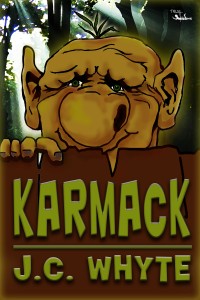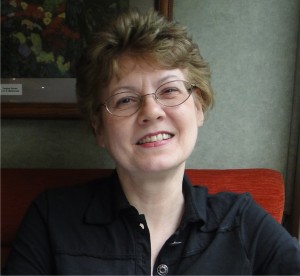Today I’m lucky to have the lovely J.C. Whyte, author of the MG fantasy KARMACK (I just love the cover of her book!), on the blog. She’s discussing how important it is to pay attention to those little flashes of inspiration that hit. Welcome, J.C.!
 I used to think Thomas Edison got it right, that “Genius is one percent inspiration and ninety-nine percent perspiration.”
I used to think Thomas Edison got it right, that “Genius is one percent inspiration and ninety-nine percent perspiration.”
Now I’m not so sure. Because I learned something valuable about inspiration while trying to get my first book published. That dream came true last year with the release of Karmack, my middle grade novel.
At the time, I had no intention of writing a children’s book. But as I lay awake one night trying to construct a scene for what I believed to be an important teen novel, inspiration struck. Yet it had nothing to do with my teen novel. My mind had drifted to more fanciful ideas. I was thinking, what if a little sprite started boomeranging bullies in true karmic fashion? The idea struck a cord with me. And I knew this would certainly be fun to write about!
So I did write about it, if only to amuse myself. Every time I encountered writer’s block with the teen novel, I’d add a couple more chapters to the children’s book. And before I knew it, Karmack was not only finished but thoroughly edited.
Well, that’s what happens when a writer gets inspiration. Ideas begin to flow, sometimes coming so fast there’s barely time to get them all down. This is probably what possessed Charles Dickens to write A Christmas Carol in six short weeks! And that masterpiece has never gone out of print. Of course, I’m not comparing my work with that of Dickens, but anyone who’s had inspiration understands how this shortcut can operate.
With Karmack complete, I began investigating sources for publication. MuseItUp Publishing promised that if the manuscript was rejected, the editors would let me know why. So I submitted Karmack to Muse, hoping to at least get valuable feedback. But to my surprise, Karmack was not only accepted but published within six months’ time!
Originally released as an ebook in 2013, Karmack continues to receive great reviews and most recently won First Place in chapter ebooks in the 2014 Purple Dragonfly competition. Muse has also scheduled a new paperback edition, which should appear in online stores soon.
Next year, Muse will be publishing a second of my books, an adventure story for adults. This book was also a lark for me to write, especially because two of the characters get trapped in an invisible dimension and are forced to communicate through a psychic’s spirit guide. Most of the action takes place aboard a cruise ship crossing the Pacific, and the narrator is the spirit guide himself. Watch for this one to be released next spring.
My teen book, however, didn’t fare as well – the Muse editors strongly disliked (I should say loathed) that manuscript. I tried endless revisions, but continued to receive only more rejection from publishers and literary agents alike. Eventually I gave up, accepting the fact I’m just not suited to write for the teen market.
The moral of my story? Pay attention to those fanciful ideas which pop into your head. Because that one percent of inspiration may not only point you in a new direction, it could also eliminate needless perspiration. And that’s what I call genius.
KARMACK blurb:
For years, Sully and his gang have tormented students and teachers alike at Higgins Elementary. And for the most part, they’ve gotten away with it. But all that begins to change when a strange little creature appears on the scene. And from that point on, pranks start coming back like boomerangs, smacking Sully and his gang right in their fifth grade butts!
Aimed at children ages 8 to 12, Karmack is also perfect for classroom read-alouds. It’s available at most online stores such as Amazon and Barnes & Noble, as well as from the publisher at http://museituppublishing.com/bookstore/index.php/museityoung/karmack-detail.
To see reviews of Karmack, go to its website: www.karmack.webs.com. Or check out its Goodreads page, http://www.goodreads.com/book/show/18080078-karmack.
From the age of eleven, J.C. Whyte knew she wanted to be a writer. But by the time she reached college, she realized an author’s income seldom paid all the bills. So she got her degrees in Journalism and Communications Management, and for many years channeled her creative energies into the field of Public Relations.
Marriage, kids, and several more degrees and occupations later (including stints as a travel agent and paralegal), J.C. entered law school – mostly for the challenge of writing creative arguments for the court. While in law school, she became a columnist for the student newsletter, writing humorous pieces on the strange and quirky life of a law student. She was absolutely thrilled when one of these articles was chosen for publication in The National Jurist, a magazine distributed to law students throughout the US.
But after graduating and passing the Bar, J.C. realized within a few years that creative writing was still what made her heart sing. So now, as a grandma, she’s returned to writing. And with publication of her middle grade novel Karmack, she’s finally fulfilled her life-long dream!






















